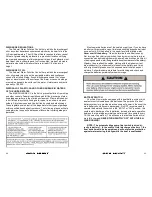
30
ENGINE SYSTEMS
Do not attempt to service any engine
or drive component without being totally
familiar with the safe and proper service
procedures. Certain moving parts are
exposed and can be dangerous.
ENGINE WARRANTY
A warranty registration card is in-
cluded with all engine manuals and
should be completed and returned to the
engine manufacturer as soon as possi-
ble.
THROTTLE/SHIFT CONTROL
The engines throttle/shift functions are located at the helm station.
Your new Sea Hunt uses two types of control boxes. All center con-
soles use a binnacle / top mount control box. Some dual console
boats may use a flush mount control box; but the operation of each
control box is basically the same.
NEUTRAL SAFETY
Your Yamaha powered Sea Hunt contains a neutral safety switch
which prevents the engine from being started in gear. When starting
your engine the control lever must be placed in the neutral/middle
position. When functioning properly, this mechanism does not allow
the engine to start when the control is not in the neutral position.
SHIFT FUNCTION
After your engine is started simply move the control lever in to the
forward detent position. To place the engine into reverse move the
control lever backwards to the reverse detent location. Remember
that propellers are designed for maximum forward thrust so reverse
thrust will not be as efficient.
THROTTLE FUNCTION
Forward Throttle:
To engage the throttle mechanism while in
forward gear position continue to move the lever forward past the de-
tent in a controlled motion. This motion will begin to increase engine
RPM which will cause the boat to move forward.
35
CLOCK
This feature is battery powered and may need to be reset if the
battery select switch is turned to the “off’ position.
FUEL GAUGE
This feature indicates the gas tank fuel level. When reading this
gauge remember two things: (1) the accuracy of your gauge varies
with the attitude of your boat in the water (trim or list heel), (2) the
fuel pickup tube inside the gas tank is not capable of withdrawing all
of the fuel from the tank. For these reasons never operate your boat
at extremely low fuel levels.
LOW FUEL WARNING INDICATOR
This feature indicates when the fuel level in the main fuel tank is
becoming low.
OVERHEAT WARNING INDICATOR
This feature indicates when the temperature of the cooling water
circulating through the engine is too high. When the temperature ex-
ceeds the recommended operating range indicated by your engine
owner’s manual, immediately shut off your engine to prevent damage.
Overheating is often caused by obstruction of your engine’s intake on
the lower unit. Check the intake strainer first if you experience trou-
ble.
TRIP METER
This feature indicates the distance traveled since the meter was last
set.
OIL LEVEL WARNING LIGHT
Refer to your engine owner’s manual for information regarding oil
level and warning light.
REVOLUTIONS PER MINUTE (RPM)
Consult your engine owner’s manual for the recommended oper-
ating RPM range.
TRIM
In general a boat is started from a stationary position with the en-
gine trimmed in. The engines are “tucked in” to the transom and will
tend to keep the bow down as the boat comes on plane. As speed is
increased and running angle reduced, the engines are gradually
trimmed out to maintain a desirable running angle. Keeping the en-
gines trimmed too far in will cause the boat to plow water and possi-
bly “bow steer”, veering unexpectedly.



































